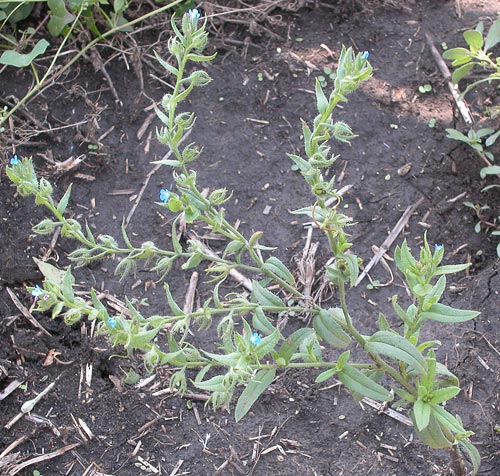Weeds
Lycopsis orientalis L. - Oriental Bugloss
Systematic position.
Family Boraginaceae, genus Lycopsis L.Biological group.
It is an annual weed, sometimes overwintering.Morphology and biology.
Stem is 10-40 cm tall, slender. Leaves narrow, entire, indistinctly emarginated. Plant has thin, rigid, erect hairs. Inflorescences long, oligofloral. Corolla 5-7.5 mm in length, not longer than calyx; its tubule is bent below middle. Fruit is a nutlet, 2.75-3.5 mm long, 1.7-2.1 mm wide, and 1.25-1.75 mm thick, oblique-oval, strongly flattened. Site of nutlet attachment is narrow. The nutlet is dark-gray, densely rugose, with fine tubercles between wrinkles, blunt at apex. Blossoming occurs in May-June, fructifying in July-August.Distribution.
The species is distributed throughout Anterior Asia, Afghanistan, Tibet, on the Balkan Peninsula; in the European part of the former USSR (southern areas), in Crimea, the Caucasus and Central Asia.Ecology.
The species is drought-resistant; therefore it is distributed in the southern droughty zone, where it grows in steppes, dry thickets of bushes, along roads, dwellings, in pastures, fallow fields, at foothills, irrigation ditches, along mountain river banks.Economic significance.
This weed and ruderal plant grows among crops of perennial grasses, grain cereals (barley, oat, millet, but mainly winter wheat), in vineyards, gardens, kitchen gardens, in crops of lucerne, cotton, and flax. It strongly litters the ground. Control measures include agronomical actions and chemical weeding.Reference citations:
Keller B.A., ed. 1934. Weed plants of the USSR. V. 3. Leningrad: AN SSSR. 448 p. (In Russian)Maevskii, P.F. 1954. Flora of middle belt of the European part of the USSR. Moscow-Leningrad: Selkhozgiz. 912 p. (In Russian)
Nikitin V.V. 1983. Weeds in the flora of the USSR. Leningrad: Nauka. 454 p. (In Russian)


